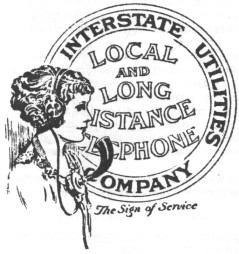Ma Bell's Place
by Vic Sumner
Reprinted from "Crown Jewels of the Wire", January 1990, page 5
LOVER'S TELEGRAPH
Although it is now an indisputable fact that Alexander Graham Bell was the
first person to receive a patent for a telephone instrument, he was not the
first to lay claim to this most important invention.
Many were those who came
forward to dispute Mr. Bell's claim. So convincing were some of their arguments
that even foreign governments became embroiled in the dispute. One French
inventor was so convincing that his government granted him a pension for life as
a reward for his service to science. The Russians, of course, also boasted that
the first "tele-phone-ski" was a product of their ingenuity. But, alas,
leave it to old Ma Bell to come up with the true story of the birth of the
telephone.

A brilliant English physicist, Robert Hooke, recorded that he had
experimented with an acoustical devise for the transmission of sound over a wire
as far back as 1667.
During the 1830's and '40's, another prominent English
physicist, Sir Charles Wheatstone, was deeply involved in the perfection of
the telegraph. As a byproduct of that work he further developed Hooke's
acoustical concept. By stretching a string between two "voice boxes" he and
his assistant were able to talk over distances of several yards. Thus was born
the acoustical telephone.
However, at that time the word telephone was known but
to a very few. The telegraph, on the other hand, had just been born and had the
world's rapt attention, thus the term telegraph was more applicable. The talking
device had found a good deal of popularity with young sweethearts which led to
the title still used today, LOVER'S TELEGRAPH.
It seems unlikely that our
sophisticated society of today could comprehend how important this simple device
became. Just as the horse filled an important need before the advent of the
automobile, so did the Lover's Telegraph supply an answer to the communication needs of our predecessors. It was widely adopted for commercial and social use
in the U.S. just about the time the telephone was being introduced.
Various
publications of the period advertised the merits of this simple telephone. The
Agriculture Almanac printed in Lancaster, Pennsylvania in 1879, did a story
titled, "How to Construct a Farmer's Telephone." They claimed a working
range of 1000 feet using a conductor made from "tape such as is used by
ladies for their dresses." Where support for the tape was required they
recommended to "fasten flatwise to the top of a spiral spring." They
further recommended a piece of an old kid glove or stout paper be stretched over
the mouth of a kerosene lamp chimney, attaching the conductor tape to the
"drum head thus fashioned." The user was to speak into the other end
of the chimney. A similar device was to be used at the distant end.
The Sacramento (California) Bee reported two cans and a coil of wire were used in
Sacramento between 1879 and 1889 by the late J. Garrison to communicate
between his home and business. A pencil was kept handy to tap the end of the
cans as a means of signaling the distant can that a call was coming in.
Incidentally, Bell's first commercial telephone used a similar method of
signaling.
And from our partners out in Galveston, Texas, as reported in a 1905
issue of Telephony a description of how one G. F. Bell (no relation), proposed to
make a "home telephone." Make tight wooden boxes 6 x 6 x 14 inches,
open on small ends. "For drum (diaphragm) use rawhide 6 inches wide, 12
inches long: Soak in strong solution of ashes and water until hair will slip"
then attach rawhide patch over one end of each box. Use #19 smooth wire, copper
is best, but iron "will last until you are tired of the telephone." He
goes on to tell you how to bore a 1-1/2 inch hold through the wall of house in
direction you want the wire to go." For insulators ho recommends cloth
strips be nailed to side of house: nothing fancy like spiral springs as used in
Lancaster, Pennsylvania.
The one thing he failed to tell the readers was how do
you explain to the little woman the 1-1/2" holes in the wall to say nothing
of those doth strips nailed to the side of the home!
MA
© ALL RIGHTS RESERVED
| 